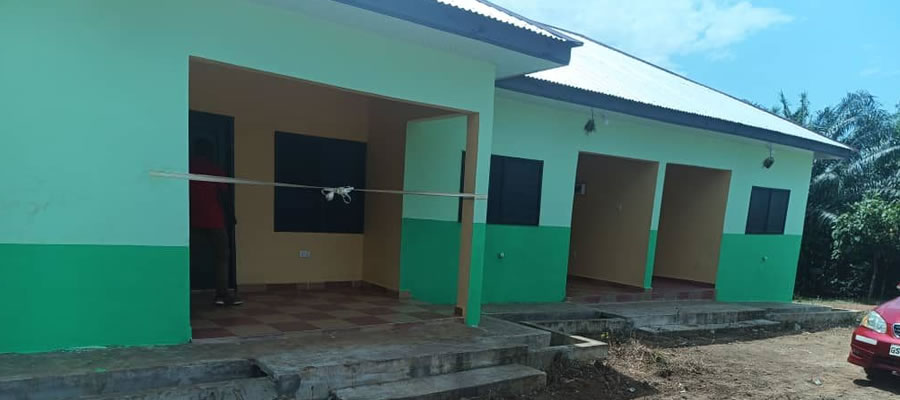

Relevant Data
Location and size
The Twifo Hemang Lower Denkyira District is located on the north-western part of the Central Region of Ghana. It is bounded to the North by the Twifo Atti Morkwa District; to the South by the Abura-Asebu-Kwaman-Kese, Cape Coast Metropolis; to the West by the Wassa Mpohor District and to the East by the Assin North Municipality and Assin South Districts. The new district consists of two (2) paramountcies, namely: Hemang and Denkyira and it is coterminous with the Hemang - Lower Denkyira constituency with about 96 communities and covers an area of 674km2 making it one of the largest districts in the Central Region.
Topography and Drainage
The general altitude is between 60-200 meters above sea level. The highest point in the District is Bepotsin (212 meters), west of Mfuom. The Pra River and its tributaries including Obuo, Bimpong and Ongwa drain the area. The Kakum River also takes its source from the Kakum Forest Reserve. The District has generally an undulating landscape making it suitable large scale agricultural activities to create more job opportunities for the district’s population.
Climate
Climatically, the District lies within the semi-equatorial zone marked by double maximal rainfall with peak in June and October, with the mean annual rainfall being 175cm. It has fairly high uniform temperatures ranging between 26°C (in August) and 30°C (in March). Relative humidity is generally high throughout the year, ranging between 70-80 per cent in the dry season and 75-80 percent in the wet season. This coupled with the topography and drainage types support agriculture which is the largest employer of the district’s population.
Vegetation
The District’s vegetation consists basically of two forest types that is, tropical rainforest to the south and the moist semi deciduous forest to the north. The vegetation has been largely disturbed by human activities through farming and logging among others. There are, however, large areas of forest reserve notably the Pra –Suhyien Block II which houses the Kakum National Park under the Jukwaim (Jukwa) stool. The forest is of the Celtis-Triplochiton association and it is moist ever green type located between Jukwa and Ankaako stretching from Jukwa Krobo through Frami, Bremang, Abrafo Odumase covering an area of 29.71 km2. The forest reserve is home for numerous notable plant species together with 82 species of mammals, reptiles and bird.
Currently, there is no exploitation taking place in the reserve and no encroachment has been detected. However, illegal hunting has been the norm for the forest fringe communities even though there is communal right to hunt without permit for hunting expeditions. Again, few chainsaw operations have been detected due to the high demand of wood product from the neighbouring districts.
The District is a densely forested area. The extensive forest has given rise to a large-scale timber extraction and illegal chainsaw operations in District. Apart from lumbering, the other major economic activities include crop/livestock farming and small-scale mining. The slash and burn method of farming coupled with these activities, among others, have caused some form of environmental degradation.
The extraction of timber has immensely depleted some economic trees, deteriorated some roads and caused some sort of destruction to cash and food crops. Farming practices have also affected the environment adversely by reducing the forest from primary to secondary state. Small-scale mining activities have equally caused extensive destruction to the vegetation and degraded large tracts of land. In effect, these have affected the ecosystem negatively.
Geology and Minerals Deposits
The land area is underlined by Birimian and Tarkwaian rocks which are very rich in mineral deposits. The minerals found in the district include; Gold at Mfuom, River Botro and Afiafiso, whilst diamond deposits can be found at Afiafiso. A feasibility study on these potentials needs to be carried to establish their economic viability and possible exploitation. This creates an opportunity for small scale mining activities. However, a comprehensive regulatory procedure should be instituted to avoid the negative consequences of mining on the otherwise serene natural environment with huge tourism potentials.
Soils, Ecological Zones and Agricultural Land Use.
The District has five (5) main soil types found in the vegetational belts. They include:
Nta-Offin Associates:- These soil are developed over rocks, which are poorly drained. They are generally suitable for the cultivation of tree crops such as citrus, cola and oil palm. In addition to the tree crops, these soils tend to support semi-perennial food crops, dry season vegetables, sugar cane and rice. They are found around Brofoyedur and Bukruso.
Asuansi-Kumasi Associates: These are soils developed over Tarkwaian rocks, which are moderately drained and are good for the cultivation of tree crops such as cocoa and forestry products. They also support food crops such as plantain, cocoyam, maize cassava and banana. They have low soil nutrient and require nitrogen and phosphorus fertilizer usage. Leaching needs to be avoided. These soils are found in the southern section of the District around Jukwa, Watreso and Krobo.
Bekwai-Nzema-Oda compound: These soils are suitable for the cultivation of perennial tree crops such as coconut and citrus and food crops such as maize cassava and cocoyam. They are found around Bepobeng, Moseaso, Nyinase and Tweapease.
Juaso-Manso-Kyekyewere-Kakum Compound;- These soils support perennial tree crops such as cocoa, oil palm, coconut, coffee and food crops including maize, cassava and plantain. They can be found around Mafi, Bonsaho, Ashire, Mmbraim, Afiaso, and Wawase areas.
Date Created : 11/30/2017 4:33:25 AM








 facebook
facebook
 twitter
twitter
 Youtube
Youtube
 +233 593 831 280
+233 593 831 280 0800 430 430
0800 430 430 GPS: GE-231-4383
GPS: GE-231-4383 info@ghanadistricts.com
info@ghanadistricts.com Box GP1044, Accra, Ghana
Box GP1044, Accra, Ghana